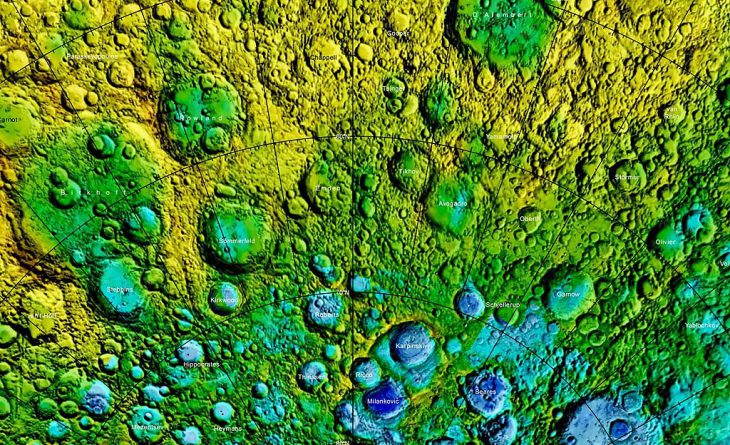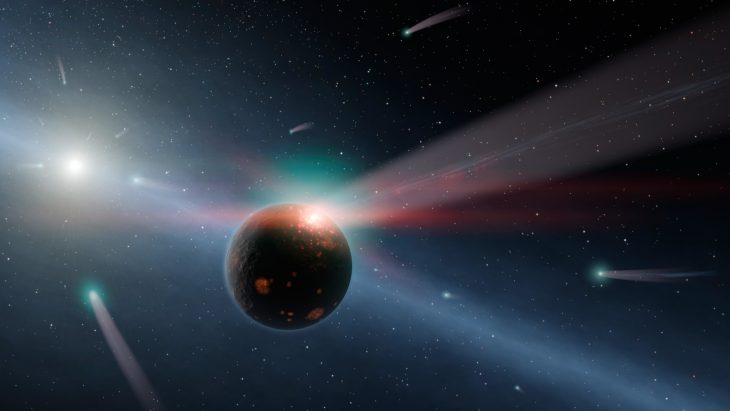The first cells of life on Earth had a lot to contend with. Conditions were harsh and unpredictable. The air was thick with volcanic gases. The oceans were boiling. The weather forecast was perpetually lava with a chance of meteor showers. Continents were absent, and nutrients were scarce. Harmful ultraviolet rays probed the surface like restless hands seeking to unravel newly formed strands of DNA.
The young Earth cooled enough in tens of millions of years for liquid water to condense, forming the warm, shallow ponds that Darwin first envisioned as life’s cradle. Even then, a constant barrage of asteroids pounded Earth’s surface, vaporizing the oceans and sterilizing the planet. Large-scale impacts would have created a lethal bottleneck for life’s long-term survival.
The timing and intensity of impacts on the early Earth are hotly debated. Geologists studying Earth’s early impact history have one major hurdle to contend with – virtually all the rocks from that time have been destroyed or recycled. Cosmochemists have traditionally turned to our nearest celestial neighbor, the moon, to better understand the history of these rock storms. Data collected from moon rocks show a range of impacts concentrated between 3.9 and 4.1 billions of years ago. This age range suggests a swarm of meteorites pummeled the moon around 4 billion years ago.
Researchers have proposed 2 hypotheses to explain why meteorites were hitting the moon at that time. The first, referred to as the late heavy bombardment, suggests the 4 giant planets in our outer Solar System (Jupiter, Saturn, Uranus, and Neptune) shifted around that time, sending a horde of asteroids hurtling towards the inner Solar System. The second hypothesis, known as the accretion tail scenario, proposes this range of ages was actually just the tail end of a steadily decreasing period of bombardment.
Many scientists have questioned whether lunar impact ages are even representative of what went on in the entire Solar System. Moon rocks have only been collected from a very limited geographical area of the moon’s surface by astronauts on the Apollo and Luna missions. Lunar meteorites, on the other hand, have fallen to Earth from all over the moon’s surface. Their impact ages fall outside the 3.9 to 4.1 billion year range, so they don’t favor either hypothesis. More data is needed.

This is a map of some of the craters on the moon caused by this massive asteroid impact. Wikimedia Commons
Scientists from the University of Alabama and Arizona State University have recently reached further abroad to understand more about these asteroid impacts in the early Solar System. These researchers examined 2 meteorites ejected from Vesta, the largest rock in an asteroid belt situated just outside the orbit of Mars.
They used a method called argon-argon dating to determine the age of certain kinds of glass formed from rocks that were melted during impacts on Vesta. This method relies on measuring potassium and argon isotopes in the glass. Isotopes of an element are identical except they have different numbers of neutrons. Specific isotopes of potassium break down over time to specific isotopes of argon at a known rate, so the ratio of these isotopes in the glass will tell the scientists how old it is.
The authors boosted this standard analysis with 2 innovations. First, they identified more than a hundred bits of glass that were distinct from the surrounding rock. Each bit, called a clast, represented a single impact event. Second, they zapped these clasts with laser pulses that were long enough to vaporize the glass, but too short to vaporize the surrounding area. This strategy allowed them to carefully date impacts from individual clasts without external contamination.
The Vestan meteorites captured an astonishing range of impact ages, extending from geologically recent (2.5 billion years ago), to almost as old as Earth’s formation (4.5 billion years ago). These ages overlap with proposed timings for the late heavy bombardment, but show no evidence of a catastrophic deluge. Instead, their multiple age clusters point to a steady stream of impact events over several billions of years.
The authors suggest 2 ways to interpret their data. The first possibility is the previous timeline from lunar data is incorrect because it is based on too few samples. The second is both the moon- and Vesta-based timelines are recording local impacts rather than Solar System-wide events.
The chronology of impact melting from Vestan meteorites adds to a growing body of similar evidence that asteroid impacts were the norm rather than the exception for early life on Earth. Some of these, like the Theia impact that formed the moon, nearly obliterated the planet, forcing any fledgling life to start anew, potentially many times over. Smaller impacts were beneficial for early life, as they delivered organic food molecules and produced the hot, wet environments preferred by some early microbial life forms. Geobiologists have described controversial evidence for life based on carbon compounds found in 3.95 billion year old rocks. The slow and steady impact scenario could reconcile the infant Earth’s impact history and help scientists understand when life began on our planet.


